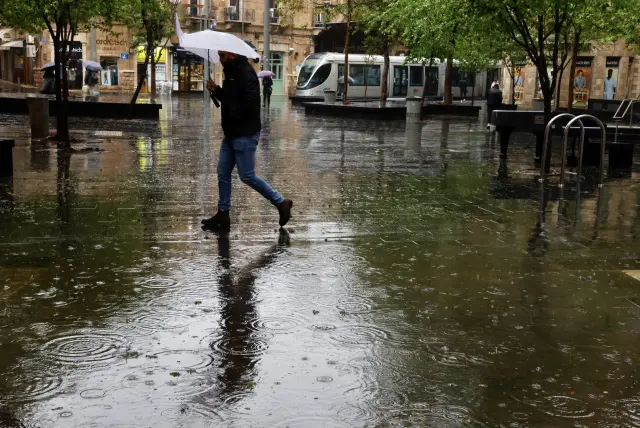Tu Bi-Sh'vat & Purim, Israeli Style
I wasn’t sure what to expect. How would the yeshivah in particular, and Israel in general (at least in Efrat), celebrate Tu bi-Sh’vat and Purim? How different would it be from my American-Jewish experiences, and particularly those in St Louis?
A Tu bi-Sh’vat seder was informally organized by a few of the dozen students in my class, and it was much like ours. The table was filled with an array of various fruits and wines, along with some harder liquor (see pic) But there was no formal seder and dinner was soup -- a tasty sweet potato version, prepared by Avraham from Brazil, one of the students; he is a chef who also cooked for one of the sheva berachot celebrating Micah and Alyssa’s wedding. (He was pictured with the shechted chickens a few blogs ago, and below in a striking Purim costume.) Surprisingly, most, but not all of the fruits were indigenous to Israel; I particularly enjoyed coconut (not indigenous to Israel). The young children and the wives of the married students were well represented. One student played the guitar.
What was unique was a slide-show/quiz about trees. Some Americans are proficient at identifying trees and plants, but my knowledge is limited to pines, oaks, maples, and dogwoods, etc. Israel’s early deep connection with the land and agriculture means that many are more deeply connected to and can identify botanical life, reinforced by formal school and informal family trips throughout the country.
Indeed, the TaNaCH is filled with botanical references and symbolic interpretations, as is later midrash and modern Hebrew poetry and song. Moreover, there are various agricultural laws: prohibitions against eating from fruit trees within their first three years, and then still another year (the fourth); the prohibitions of sh’mittah (the seventh year), and the obligation to know about fruits and vegetables in order to recite the correct berachah before enjoying them. Tu bi-Sh’vat itself marks the date when trees become a year older, much like a horse which becomes a year older every January 1, even if it was born on December 31.
The slide-show and quiz of Israeli trees was therefore beyond me and even harder because it required identifying the trees in Hebrew. The celebration was informal and light.
Purim at the yeshivah was similar to what I have experienced in the US. The reading, with the symbolic booing of Haman, took about an hour. Some of the twenty-something students and their children dressed up and acted silly, sounding musical instruments, banging on the table, and expressing odd noises. Pro-Jewish verses sometimes received unexpected applause. Another student raised various silly signs. Others threw paper airplanes; at one point it looked like an airport. And one student, like Justin does for us, raised an item to signal “quiet” so as to enable hearing the reading.
What did surprise me a bit was that Israel, or at least nearly all of Efrat, shut down to celebrate Purim. The stores I have cited in previous blogs, including the supermarkets, were closed. So even were the pizza shops. Following the night reading, Ezra, Shiri and I wanted to get a pizza, but it was closed. I had assumed that it would be open and it was a natural fit. We then drove to another pizza place, but it too was closed. Burger’s Bar, however, was open for business and we enjoyed its fare.
Purim day was interesting. Although the stores were closed, the parties were open. When I left to see Micah and Alyssa and deliver mishlo’ach manot, I saw that my street was so packed with cars that I was sure it would be hard to find a spot to park when I returned an hour or so later. Outside, in private homes and in the street, there was music and dancing, and many adults as well as children were dressed up in costume. (See photos and video.)
It makes sense. Not only is Purim the rare holiday without religious restrictions (the rabbis could not impose them because Purim was post-Torah -- and therefore they did not outright forbid work, but they come close by asserting that any work on Purim would not be blessed; in other words, it was a waste). Therefore, Purim is a special opportunity, like Yom ha-Atzma’ut and Chanukah, for observant Jews to drive and to be able to use fire, etc. Purim’s theme is unlike other American holidays, but in practice it is similar to those Monday holidays, such as this year when it fell on Thursday, serving as a three-day break.
And Purim is featured in the newspapers, from pictures of celebrants in the synagogue listening to Megillat Esther to those dressed in costume in the streets. It seems that Purim is a broad national holiday for the religious and the non-religious alike.
Jerusalem, however, celebrates Purim on the next day, the 15th of Adar. A series of complicated halachot and interpretations are entwined, including what exactly constitutes Jerusalem? The range of answers include (a) a town from where you can see Jerusalem, or Jerusalem suburbs, which few practice; to (b) the most narrow interpretations of sections of the Old City. The middle view is the most accepted -- within the municipality of Jerusalem.
I hope that the pictures and videos I have included will give you a glimpse of Tu bi-Sh’vat and Purim. Next up -- Pesach.
PS -- On Friday morning, March 30, I will be conducting a siyyum on Talmud to override the fast of the first-born via FaceTime. I am looking forward to seeing you and to being seen!






















